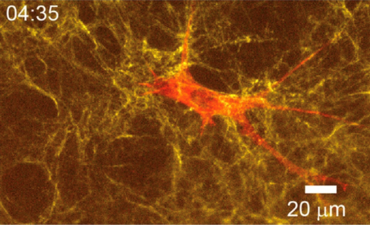A dashboard to study cell movement
Individual cells move in vivo in complex 3D environments. Their motion occurs at zero force and requires symmetry breaking. In this study at the interface between physics and biology published in the journal eLife, scientists are interested in understanding the origin of symmetry breaking. They show that there is a phase shift between force dipoles on either side of the nucleus, which allows the cells to advance in a 'forest' of fibers. This work, integrating experiments and theory, provides a dashboard that indicates the essential data to understand the movement of cells. They open new perspectives for the understanding of cell movement in physiological and pathological contexts.

Purcell proposed in a 1977 paper that low Reynolds number movement requires unavoidable rules: in an inertia-free world, symmetry breaking must be inherent to moving objects. This fundamental law which concerns all moving objects of sub-micrometer size is however little understood experimentally.
In this paper, the researchers shed light on the origin of symmetry breaking in cell movement, by placing individual cells in a 3D matrix close to physiological matrices. Using this device, they observe the major actors of displacement: focal contacts, acto-myosin cytoskeletons and microtubules, in correlation with extracellular matrix displacements. The results show that cells only move if there is a persistent phase shift between contractions on either side of the nucleus.
To go further in the analysis, they identified the parameters they wanted to measure and thus determined a space in which the directional movement is characterized: the dipole-quadrupole diagram. If this diagram has a finite area, the cell moves forward. This unusual representation provides a robust dashboard for characterizing cell motion. They even controlled the cell movement by inducing dipoles locally with a laser.
This study at the interface between biology and physics opens original perspectives for the understanding of cell movement in physiological contexts, but also in pathological situations such as metastasis during which cells migrate uncontrollably.
